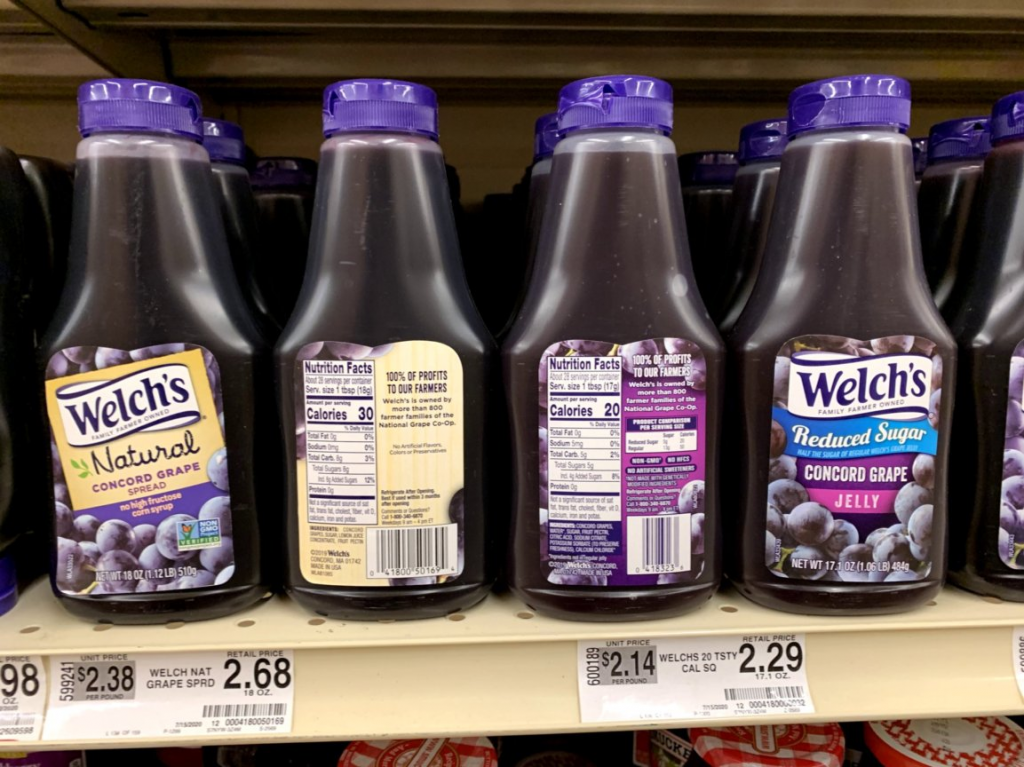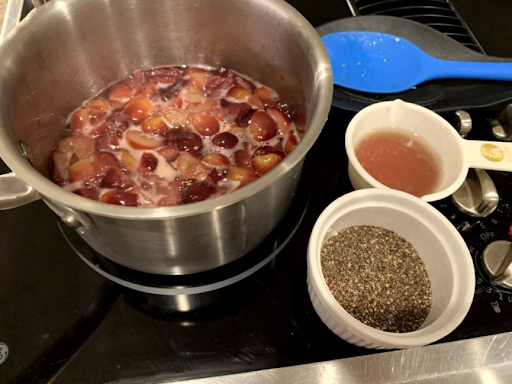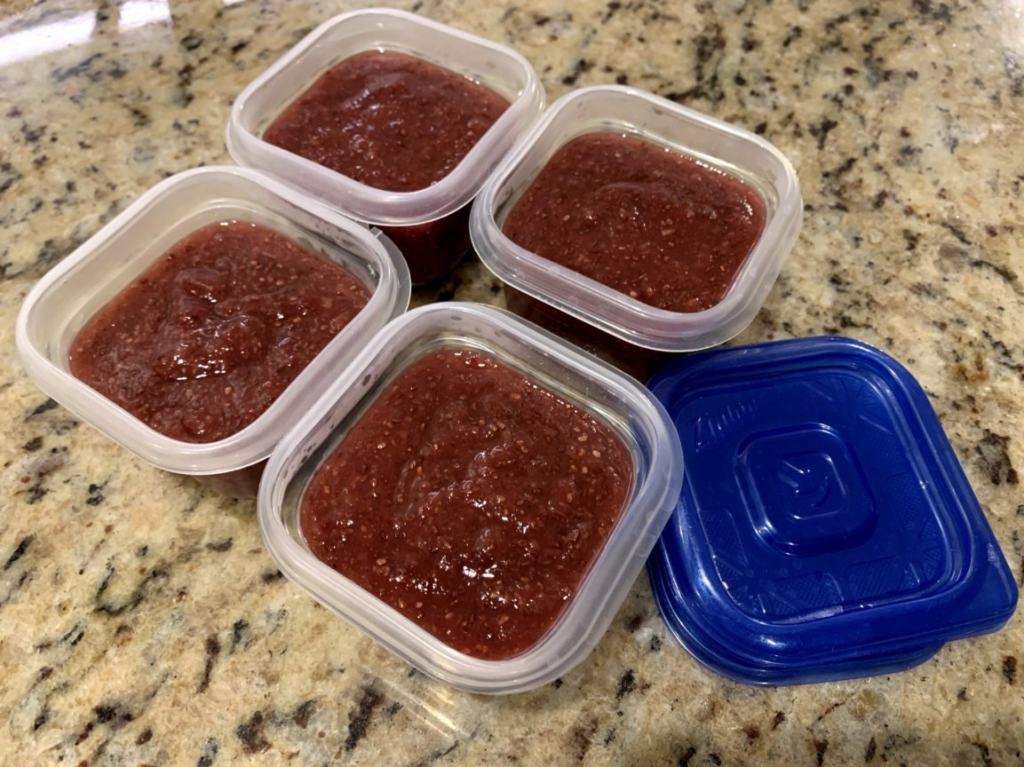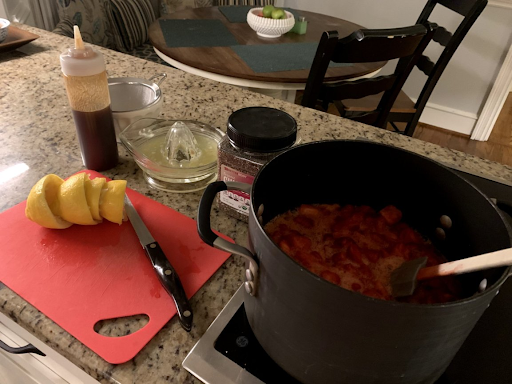Whether our children are at home or back in person, lunch making continues to beckon. If your kids are anything like mine, their top picks revolve around hot dogs (yes, I know), quesadillas, mac and cheese, and ol’ fashioned peanut butter and jelly.
I recently discovered this classic can serve up not only a meal but also a learning opportunity for our kids, as well as us Smarty Mamas who may be doing the grocery shopping.
So here’s what happened…
At the market last weekend, I was restocking some pantry supplies. I also may or may not have been doing some odd Mama Bird nesting out of nerves. My two just returned to in-person school two days a week. Being the recently certified nutritionist I am (cue the groaning like my family does whenever I talk shop), I decided to do as I’d been taught: read the labels. For a while now, I’ve been assuming Choice B is the wiser one. I’ve been wrong.
Choice A (Welch’s Natural)/Choice B (Welch’s Reduced Sugar)
For a while now, I’ve been feeling pretty Smarty because I have not fallen prey to the “Natural” branding (And I’ve been saving $. Take that, Marketing gurus!). The reduced sugar was my preference since it, well, has less sugar; however, what I’ve been decreasing in sugar by only 2 grams per serving, we’ve been gaining in all sorts of additives and preservatives. Warning: Don’t start Googling these unless you want to be freaked out.
The amount of added sugar we consume around here is already at a pretty reasonable level. Snacks are usually plain fruit or veggies, low-sodium nuts, or low-sugar dairy items grabbed from the fridge vs. pantry wrapped goodies that last for months (Shhh, Girl Scout Cookies.).
All that to say, the tradeoff for less weird stuff in Choice A (concord grapes, sugar, lemon juice concentrate, and fruit pectin) vs. Choice B (concord grapes, water, sugar, fruit pectin + citric acid, sodium citrate, potassium sorbate, and calcium chloride) makes more sense for a minimal sugar difference. I should’ve known too since Choice A and B both say refrigerate after opening, but A is “best if consumed within 3 months”. I have no clue how long B lasts…
But you see, I live on the edge, so I thought, Why don’t I just make my own?
Enter Choice C. After all, I had some red grapes that were starting to pucker and I don’t like waste, so I went for it. The jam relies on chia seeds to produce that jammy texture. “Ch ch ch chia!” It feels only right to sing this super seed’s praises because it adds so much to an everyday breakfast/lunch spread. Chia seeds are high in fiber, protein (a complete one), and calcium. Bonus fun fact: “They are the richest plant source of omega-3 fatty acids,” per Harvard School of Public Health.
Another win for Choice C? It can be a real-world edu experience. You can start at the store by doing a little math, science, and debate. Ask the kiddos to compare the look, cost, and labels. Which would they buy? Why? Then, explain the contrasts and your decision to just try to prepare it yourselves. At home, making the jam creates another chance to involve math with all the measuring and batching. Turn it into a literacy and science experiment by having them record and research their hypotheses: How many grapes will it take to make so many cups of jam? What will happen to the mix by adding chia seeds? How long will different types of jam last in the fridge without preservatives? With? What are food preservatives?
Full transparency–I do not make everything from scratch.
I love salami, Doritos, and marshmallow fluff. We order pizza on occasion. The list goes on. I also do not deem foods “bad” or “good” (except for those buffalo pretzel bites my husband likes to consume while working from home); however, I do like to abide by sound dietary principles. I am a tough culinary critic who strives for cooking that is:
– Nutritious
– Delicious
– And most importantly–Doable for real life
This jam checks all those boxes. Make a bunch of it, and freeze. Take out little containers each week when you run out, and they thaw in the fridge overnight. You can also nuke them on defrost in the microwave at 30-second intervals, stirring.
I’m glad I tried this. And I’m even happier the jam turned out. I thought I’d share it today with some of you who are also hoping to bring more foods back to basics this year. Or those of you who need something to do with your kids when they finish school at 10 am and can handle no more LEGOs.
What weekly staple have you tried to take back to basics? How’d it turn out? Would love to hear more doable ideas in the comments from you Smarties!
Recipe – Grape Jam
Yield: 2 C (I stored as four ½ C portions)
1) Coarsely halve 2 ½ C of grapes (about 50 grapes total–a good counting/sorting exercise for wee ones).
2) Cook in a pot over medium for 20 minutes.
3) Add to the pot:
– 2.5 T chia seeds (equivalent = 2 T + 1 ½ t)
– 2.5 T honey (equivalent = 2 T + 1 ½ t)
– 1 T & 1 t lemon juice
4) Immersion blend right in the pot, or puree in a blender once slightly cooled.
5) Ladle into glass jars (plastic ware does well too), allow to cool, chill or freeze, and enjoy.
Recipe – Strawberry Jam
Last June, I posted this one in “Savoring the Harvest: What to do with All Those Berries (And Your Tween)!” for all you Smarties out there who enjoy berry pickin’ too. Here it is again if your children prefer strawberry jam. Keep this one near… picking season is around the corner–hooray! Of course, you can make it anytime with frozen berries too.
Yield: 20 (4 oz.) jars or 10 (8 oz.) jars
You can make smaller batches too. I make this generous amount after a berry farm outing.
1) Coarsely chop 10 C of berries. Rinse to thaw if using frozen berries.
2) Cook in a pot over medium for 10 minutes.
3) Add to the pot:
– 10 T chia seeds
– 5 T lemon juice
– 10 T honey
4) Immersion blend, or puree in blender.
5) Cool, ladle into glass jars (plastic ware does well too), chill or freeze, and enjoy.










